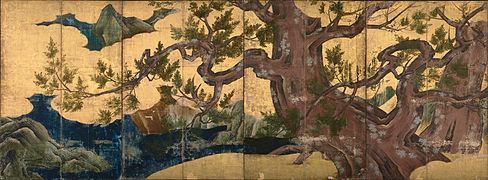Kanō Eitoku
Kanō Eitoku ( Japanese 狩 野 永 徳 , real name Kanō Kuninobu (狩 野 州 信), nickname Genshirō (源 四郎); born February 16, 1543 in Kyoto ; died October 12, 1590 ) was an important Japanese painter and most important representative of the Kanō -School of Japanese Painting in the Azuchi Momoyama Period of Japanese History. His works are known for their elegant and unique style, many of the surviving paintings are Important Cultural Assets of Japan and three - murals in the Jukō-in of the Daitoku-ji complex, a screen-drawn view of Kyoto (now in the Uesugi Museum Yonezawa ), as well a cypress picture on a screen (now in the Tokyo National Museum ) - are the national treasures of Japan .
Live and act
Eitoku was the eldest son of the painter Kanō Shōei . At an early age he began to paint under the guidance of his grandfather Kanō Motonobu , court painter for the Ashikaga shogunate , and showed his artistic talent. At the age of about twenty he was already an active painter, initially painting pictures on wooden sliding doors, so-called Fusuma-e (襖 絵). In 1566 he painted, with the help of his father, Fusuma-e for the reception hall in the Jukō-in (聚光 院), a sub-temple of Daitoku-ji , which the Daimyō Miyoshi Yoshitsugu (三好 義 継, 1549-1573) in memory of his father, Miyoshi Nagayoshii (三好 長慶, 1522–1564) had it built. The ink painting entitled "Flowers and Birds of the Four Seasons" (四季 花鳥; Shiki kachō-zu), which adorns the most important room in the building, the "Shitchū" (室 中), gives an impression of the artistic strength of the young Eitoku .
When the military leader of Japan Oda Nobunaga came to Kyoto in 1568 , he was very impressed by Eitoku's new style and made him an official painter. Eitoku painted the two six-part display screens “Views of and around Kyōto” (洛 中 洛 外 図 屛 風, Rakuchū rakugai-byōbu), which Nobunaga gave to Uesugi Kenshin in 1574 and which are still owned by the family today. The pair of adjustable screens, painted in brilliant colors on a structured gold background, very vividly shows the palaces and temples as well as life in and outside the city.
When Nobunaga had a large, modern castle built on and on the Azuchi Mountain on Lake Biwa , Eitoku and other members of the Kanō clan designed the murals and pictures on the wooden sliding doors. For the guest rooms and for the castle tower complex, Eitoku designed a series of plant and bird pictures as well as genre scenes. They were executed as so-called "Dami-e" (濃 絵), that is, as images on gold in voluminous pigments. Eitoku also painted a screen showing the newly built castle and the castle town that belonged to it. This screen was later sent to the Pope in Rome.
Azuchi Castle burned down in 1582 after Akechi Mitsuhide drove Nobunaga to seppuku . Toyotomi Hideyoshi , who had seized power after Nobunaga's death, also occupied himself very much more with the building of palaces, temples and shrines and commissioned Eitoku continuously. Construction began with the construction of Osaka Castle in 1583, followed by the Jūrakudai Palace (聚 楽 第) in Kyōto in 1587, the construction of the imperial residence under the name Ōgimachi-in Gosho (扇 町 (御所) and the (no longer existing ) Tenzui-ji Temple (天瑞 寺). While working on the large dragon painting in the main hall of Tofuku-ji in 1588, Eitoku collapsed. While the painting was being completed by his student Sanraku , Eitoku recovered. Soon he began to work again, designing sliding doors for the imperial palace, but died unexpectedly in 1590.
Eitoku received the honorary titles "Hōgen" and "Hōin". Most of his works disappeared with the destruction of the palaces, such as those in Azuchi Castle or Jurakudai, only a few can be clearly assigned to him. Eitoku merged the colors of the Tosa school with the intellectual level of black ink painting, and created works that were impressive for the time thanks to the lush gold background.
The painters Hasegawa Tohaku and Kaihō Yūshō were contemporaries and rivals of Eitoku.
photos
- National treasures
Remarks
- ↑ Xu You (許 由) was a legendary Chinese hermit in ancient times. This hanging scroll and the one next to it are attributed to Eitoku.
- ↑ Chao Fu (巢父) was a legendary Chinese hermit in ancient times.
- ↑ Literally “inside and outside the branch”. That was, emphatically understating, the name for the imperial city and its surroundings.
- ↑ Hōgen (法眼) and the higher title Hōin (法院) were - together with the lowest degree "Hokkyō" (法 橋) - honorary titles that were originally awarded to high priests, but later also to artists and scholars.
Individual evidence
literature
- Tazawa, Yutaka: Kanō Eitoku . In: Biographical Dictionary of Japanese Art. Kodansha International, 1981. ISBN 0-87011-488-3 .
- National Museum Tōkyō (Ed.): Kanō-ha no kaiga . Exhibition 1979.
- Laurence P. Roberts: Eitoku . In: A Dictionary of Japanese Artists. Weatherhill, 1976. ISBN 0-8348-0113-2 .
Web links
- Literature by and about Kanō Eitoku in the catalog of the German National Library
- Kanō Eitoku on Google Arts & Culture
| personal data | |
|---|---|
| SURNAME | Kanō, Eitoku |
| ALTERNATIVE NAMES | 狩 野 永 徳 (Japanese) |
| BRIEF DESCRIPTION | Japanese painter |
| DATE OF BIRTH | February 16, 1543 |
| PLACE OF BIRTH | Kyoto |
| DATE OF DEATH | October 12, 1590 |

![Xu You [A 1]](https://upload.wikimedia.org/wikipedia/commons/thumb/2/21/Kano_Eitoku_009.jpg/120px-Kano_Eitoku_009.jpg)
![Chao Fu [A 2]](https://upload.wikimedia.org/wikipedia/commons/thumb/1/17/Kano_Eitoku_008.jpg/115px-Kano_Eitoku_008.jpg)






